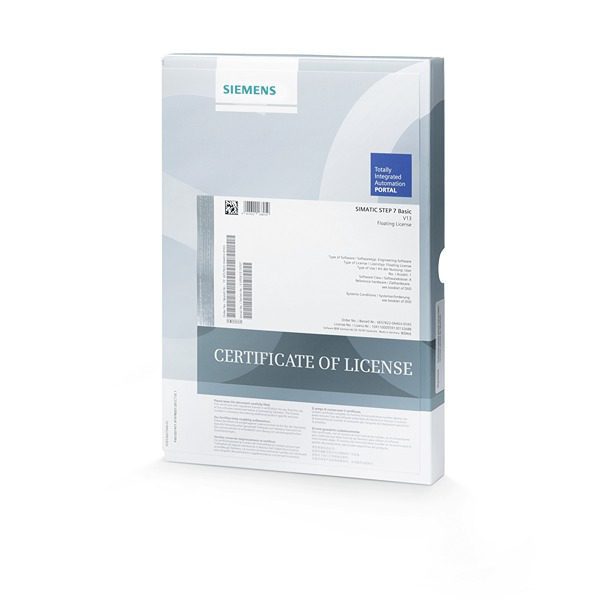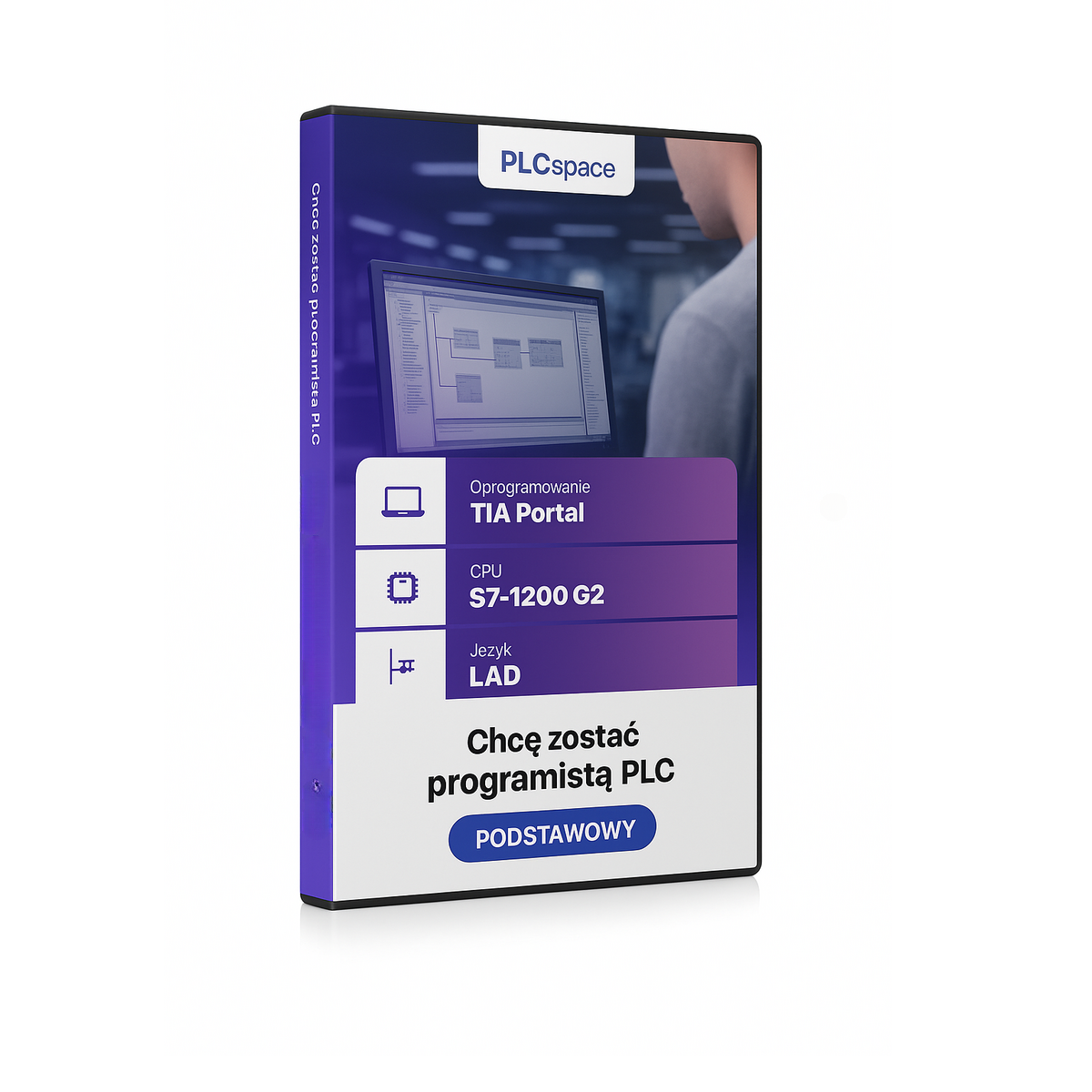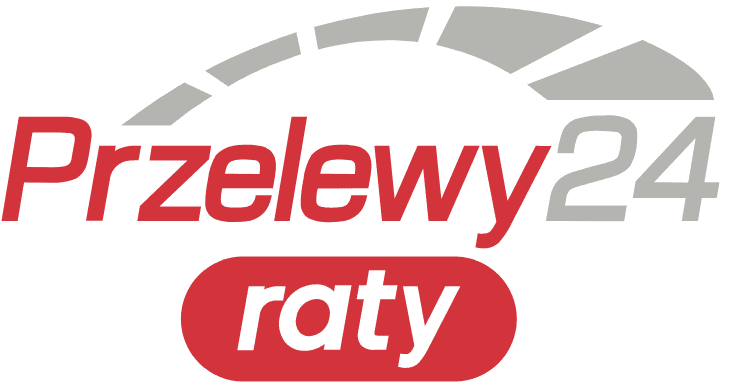I want to become a PLC programmer - Advanced
- Level:
The development environment used in the course
- Software:
Core unit family used in the course
- CPU:
A set of rules that are used to develop programme code
- Language:
Frequency converter (inverter) family used in the course
- Drive
699.00 zł Pierwotna cena wynosiła: 699.00 zł.399.00 złAktualna cena wynosi: 399.00 zł.
What do you get when you enrol on a PLC programming course?
Nie martw się, że zalejemy Cię skomplikowaną wiedzą, która może sprawić trudności w przyswojeniu. Nic bardziej mylnego! Nasz kurs został stworzony z myślą o zaawansowanych, ale jednocześnie dba o to, by uczestnicy poczuli się swobodnie nawet wśród podstaw PLC. W ramach szkolenia dostarczymy Ci starannie wyselekcjonowane materiały pomocnicze:
Chcę zostać programistą PLC. Kurs programowania PLC Siemens, poziom zaawansowany – oprogramowanie TIA Portal
Sterowniki PLC Simatic stanowią fundament w każdej gałęzi przemysłu, gdzie zastosowana jest automatyka maszynowa. Niniejszy kurs skupia się szczególnie na kluczowej rodzinie sterowników PLC – Simatic S7-1200. W trakcie części teoretycznej z pewnością zapoznasz się z opiniami na temat tych niezmiernie elastycznych urządzeń, idealnie sprawdzających się zarówno w prostych, jak i skomplikowanych projektach.
Nasza oferta szkoleniowa dotycząca PLC umożliwi Ci opanowanie zaawansowanych technik programowania sterowników firmy Siemens. Zdobędziesz praktyczną wiedzę, którą wykorzystasz w codziennej pracy.
Jeżeli posiadasz wykształcenie techniczne i marzysz o karierze w dziedzinie automatyki, lecz nie wiesz, od czego zacząć, to znalazłaś się we właściwym miejscu! Po ukończeniu naszego kursu programowania sterowników PLC Simatic zaskoczysz potencjalnego pracodawcę swoją ekspertyzą i innowacyjnym podejściem do tematu.
What is the Siemens Simatic PLC programming course about?
Nasze zaawansowane szkolenie z programowania sterowników logicznych PLC zostało starannie opracowane w taki sposób, aby kompleksowo omówić to zagadnienie z poziomu zaawansowanego. Tematy poruszone podczas kursu są niezwykle użyteczne w różnorodnych dziedzinach zawodowych, szczególnie w tych związanych z programowaniem w przemyśle. Jeśli chcesz opanować sztukę programowania i nadzorowania maszyn w fabryce, znajomość programowania sterowników logicznych PLC Siemens Simatic umożliwi Ci lepsze zrozumienie zależności między poszczególnymi komponentami.
Nasz kurs PLC koncentruje się na jednym z najpopularniejszych sterowników firmy Siemens, a mianowicie na S7-1200. W połączeniu z oprogramowaniem TIA Portal tworzy on bardzo efektywne środowisko programistyczne. Obecnie obsługa sterownika Siemens Simatic S7-1200 jest możliwa w trzech różnych językach programowania. W ramach naszego szkolenia poznasz graficzny język programowania LAD, powszechnie znany jako drabinka, co czyni go niezwykle przystępnym dla początkujących.
Nasze szkolenie wykorzystuje aplikację Industry Line, która przeniesie Cię do wirtualnej fabryki, umożliwiając praktyczne zrozumienie obsługi poszczególnych maszyn i połączenie teorii z praktyką.
Programowanie sterowników PLC Siemens S7-1200 jest wygodne, ponieważ nie wymaga dodatkowego zakupu oprogramowania ani sprzętu. Wszystkie zadania praktyczne wykonywane są w środowisku TIA Portal v. 14SP1, dedykowanym sterowaniu modułami firmy Siemens. Oprogramowanie to jest dostępne za darmo na stronie producenta, a jego pełną funkcjonalność zachowuje przez 21 dni, co jest znacznie więcej niż potrzebne do ukończenia kursu podstawowego PLC.
Czy chcesz przekonać się, że zdobycie wiedzy z zakresu programowania sterowników PLC w języku LAD nie wymaga studiowania obszernych podręczników napisanych skomplikowanym językiem? Czy masz dość jedynie teoretycznego podejścia do nauki podstaw PLC, po którym nic nie pozostaje w głowie? Wybierz nasz kurs programowania Siemens i przekonaj się sam!
Knowledge test:
Is this course for you? Take this test MULTIPLE choice to check it out.
Egzamin Summary
0 of 9 Questions completed
Questions:
Information
You have already completed the egzamin before. Hence you can not start it again.
Egzamin is loading…
You must sign in or sign up to start the egzamin.
You must first complete the following:
Results
Results
0 of 9 Questions answered correctly
Your time:
Time has elapsed
You have reached 0 of 0 point(s), (0)
Earned Point(s): 0 of 0, (0)
0 Essay(s) Pending (Possible Point(s): 0)
Categories
- Not categorized 0%
- 1
- 2
- 3
- 4
- 5
- 6
- 7
- 8
- 9
- Current
- Review
- Answered
- Correct
- Incorrect
-
Question 1 of 9
1. Question
Do the interrupt blocks change the cycle time?
CorrectIncorrect -
Question 2 of 9
2. Question
In which languages can code be written for the S7-1200 PLC?
CorrectIncorrect -
Question 3 of 9
3. Question
What states (values) can the bit assume?
CorrectIncorrect -
Question 4 of 9
4. Question
Is "state 0" returned by
CorrectIncorrect -
Question 5 of 9
5. Question
How many bits does a BYTE type consist of?
CorrectIncorrect -
Question 6 of 9
6. Question
What is the result of a comparison operation?
CorrectIncorrect -
Question 7 of 9
7. Question
What type of memory is defined as ephemeral (loss of data after power failure) ?
CorrectIncorrect -
Question 8 of 9
8. Question
Which data types consist of 32 bits?
CorrectIncorrect -
Question 9 of 9
9. Question
What bytes are included in the address %ID0 ?
CorrectIncorrect
Key information about the course
Przekonasz się, że z ochotą będziesz sięgał po dodatkową wiedzę. Nasz kurs to nie tylko omówienie teoretycznych podstaw programowania. Prezentujemy konkretne strategie, techniki oraz triki, które wykorzystują doświadczeni profesjonaliści z dziedziny PLC. Wierz nam, po ukończeniu tego szkolenia Twoi pracodawcy będą zaskoczeni poziomem Twojej wiedzy i umiejętności. Nabywasz nie tylko umiejętności techniczne, ale również rozwijasz analityczne myślenie, które jest kluczowe dla każdego zaawansowanego programisty PLC.
Choć praca jako programista-automatyk może sugerować samotność, to w praktyce zazwyczaj prezentuje się zupełnie inaczej. Specjaliści zajmujący się programowaniem PLC stają się integralną częścią zespołu, który wspólnie realizuje projekty. Nie musisz się obawiać! Po ukończeniu naszego zaawansowanego kursu poczujesz się jak prawdziwy ekspert, dyskutując o rezultatach swojej pracy z kierownictwem, inwestorami oraz kolegami z zespołu. Przedstawimy Ci strategie doboru optymalnych rozwiązań, które uwzględniają zarówno czas, jak i koszty związane z ich wdrożeniem.
Otrzymasz również wskazówki, jak unikać tych problemów i doskonalić swoje umiejętności. Większość kursów PLC dostępnych w sieci skupia się na przekazywaniu teorii. Nasza propozycja idzie o krok dalej – prezentujemy konkretne strategie radzenia sobie z pułapkami i trudnościami, z jakimi borykają się początkujący, często czując się bezradnymi. Omówimy, jak ich unikać i dlaczego ma to kluczowe znaczenie.
Wirtualna fabryka pozwoli Ci eksplorować typowe wyzwania, z jakimi spotykają się specjaliści z dziedziny automatyki w przemyśle. Pozbędziesz się stresu związanego z przyszłą pracą. Korzystając z aplikacji Factory I/O, będziesz miał możliwość testowania każdego rozwiązania, jakie przyjdzie Ci do głowy, bez obaw o opóźnienia w pracy zakładu, awarie czy wypadki. Dzięki bezpiecznemu środowisku programistycznemu możesz uczyć się szybciej i bez nadmiernego napięcia.
Dzięki wieloletniemu doświadczeniu w obszarze dużych projektów, przekazujemy sprawdzone metody programowania, które znajdziesz zastosowanie w różnorodnych sytuacjach zawodowych. W trakcie Twojej drogi zawodowej będziesz mieć kontakt z wieloma innymi programistami, z których nie wszyscy będą reprezentować wysoki standard programowania. Naszym celem jest przekazanie Ci wiedzy i umiejętności, które wyróżniają najlepszych specjalistów. Nie ograniczamy się jedynie do nauki programowania PLC, jaką znajdziesz w podręcznikach. Poprzez opanowanie sprawdzonych metod pracy w dziedzinie automatyki, będziesz wyróżniać się starannością oraz innowacyjnym podejściem do rozwiązywania problemów.
Why choose our industrial automation course?
You will find many a Simatic PLC tutorial on the market, but our training is a whole different level. What can a really great course look like?
Sample lesson / What you will do after the course
What is the Simatic S7-1200 controller programming training in the TIA Portal environment?
Our Siemens Simatic S7-1200 PLC training consists of 5 parts, each of which is dedicated to different blocks of topics. You will learn how to control PLC modules and use them in your daily work to improve the functioning of your project. What information will you find in each part?
After completing all modules, you will have a working knowledge of programming machine controllers that you can use in your everyday duties. Find out that PLCs can be easy to use. Check out the courses on offer today!
-
Module 1
- Registration on the Siemens website
- Which files to download
- Installation of TIA Portal software
- Installation of the PLCsim simulator
-
Module 2
- TIA Portal - TRIAL licence activation
- TIA Portal - activation of full licence (floating type)
-
Moduł 3 - rzeczywisty PLC
- Electrics - Diagram
- PC/PG preparation
- Search for PLC on Ethernet/PROFINET
- Adaptation of the PLC for the course
-
Moduł 1 – wprowadzenie do sieci PROFINET
- Model komunikacyjny
- Widok dostępnych urządzeń na sieci
- Adresowanie urządzeń PROFINET
- Nadawanie nazwy urządzeniom PROFINET
- Dodawanie rozproszonych wejść/wyjść do projektu (zakładka Network View)
- Konfiguracja połączenia z CPU
- Konfiguracja rozproszonych wejść/wyjść (zakładka Device View)
-
Moduł 2 – obsługa wejść i wyjść analogowych
- Pomiar wielkości analogowej
- Zamiana wartości ciągłej na dyskretną
- Dokładność przetwornika
- Moduły analogowe wejściowe
- Podłączenie czujnika do modułu AI
- Konfiguracja modułu AI
- Sprzętowe uśrednianie mierzonej wartości
- Reprezentacja wartości dla AI
- Obliczanie wartości surowej na wielkość fizyczną
- Funkcja normalizacji
- Funkcja skalowania
- Sterowanie procesem z wykorzystaniem wartości analogowej
- Podłączenie elementu wykonawczego do AQ
- Reprezentacja wartości dla AQ
-
Moduł 3 – wprowadzenie do języka SCL
- Kaskada IF … ELSIF
- Pętla FOR
-
Moduł 1 – Serwer WWW wbudowany w CPU
- Aktywacja serwera w konfiguracji sprzętowej PLC
- Konfiguracja uprawnień użytkownika
- Dostęp do CPU przez przeglądarkę internetową
- Informacje podstawowe o PLC
- Bufor diagnostyczny
- Status PLC oraz dołączonych modułów
-
Moduł 2 – Logowanie danych
- Dane potrzebne do utworzenia logu
- Funkcje do pracy logami
- Tworzenie logu
- Zapis wartości zmiennej do logu
- Dostęp do pliku logu przez stronę WWW
- Podgląd pliku przez program Excel/Notatnik
- Wykorzystanie innych funkcji do obsługi logów
-
Moduł 3 - Receptury oraz bloki DB w pamięci LOAD
- Receptury – przedstawienie idei
- Deklaracja rekordu danych – User data type
- Receptura – blok DB zawierający tablicę wielu rekordów
- Wartości początkowe dla rekordów receptury
- Funkcje do obsługi receptur
- Odczyt rekordu z bloku DBL
- Zapis rekordu do bloku DBL
- Zapis receptury do pliku .csv
- Dostęp do pliku receptury przez stronę WWW
- Edycja pliku receptury w Excelu
- Załadowanie nowej receptury przez WWW do pamięci CPU
- Odczyt pliku receptury do bloku DBL
- Sprawdzenie odczytanych danych
-
Moduł 4 - Szybkie liczniki (HSC)
- Porównanie licznika programowego i sprzętowego
- Dostępne typy zliczania zdarzeń
- Aktywacja szybkiego licznika
- Konfiguracja szybkiego licznika
- Pomiar liczby obrotów wału silnika
- Przerwania sprzętowe od szybkich liczników
- Programowa zmiana nastaw szybkiego licznika
-
Moduł 1 – Diagnostyka PROFINET/PROFIBUS
- Wykorzystanie funkcji LED()
- Odczyt statusu urządzeń sieciowych
- Zapis informacji do bufora diagnostycznego
-
Moduł 2 – Modulacja szerokości impulsu (PWM)
- Rodzaje wyjść impulsowych
- Aktywacja wyjść impulsowych
- Konfiguracja wyjść impulsowych
- Sterowanie wyjść impulsowych
- Programowa zmiana wypełnienia
-
Moduł 3 - Bloki danych – zaawansowane możliwości
- Funkcjonalność snapshot
- Rezerwacja pamięci dla dodawania zmiennych „w locie”
-
Moduł 4 - Regulator PID
- Koncepcja budowy układu automatycznej regulacji
- Schemat blokowy układu z regulatorem PID
- Koncepcja PID
- Regulator PID w SIMATIC S7-1200
- Dostępne obiekty technologiczne dla regulatora PID
- Omówienie obiektu regulacji
- Parametryzacja PID_Compact
- Wywołanie PID_Compact w kodzie programu
- Uruchomienie i strojenie regulatora
- Funkcjonalność Autotuning
- Zapis nastaw regulatora do pamięci
Software and hardware used

TIA Portal software
Totally integrated automation is a development environment that combines PLC (programming), HMI(visualisation) and startdrive(drive technology).

CPU S7-1200
The new controller, which has been developed as a successor to the S7-200, is characterised by slightly weaker parameters than the S7-300 family. Several CPU versions present in the family allow selection according to project requirements.
What will you be able to do after completing the course?
The effort you put into completing the course will undoubtedly pay off - knowledge of PLC programming will open the door to many jobs. Choose your specialisation according to what you most want to do
Learning based on dry theory is a relic. We offer you the chance to explore practical skills, something that really matters to employers. Our training will enable even someone with no programming experience to receive ready-made solutions that will help them find their way in the job market.


Guarantee
and certificate
If, after 14 days of purchase, you find that it is not for you, I will refund 100% of the course price. Upon completion of the course, you will receive a certificate in two languages - Polish and English.

Frequently asked questions
-
Will I receive a confirmation after my purchase?
Yes, you receive an email. Sometimes emails end up in SPAM or other folders. Please check your mailbox carefully.
-
Is there a difference between the media on which the course can be ordered?
No. The material is the same regardless of the type of storage medium. At the time of purchase, you decide which type of data carrier you choose, i.e. online, DVD or USB.
-
Which PLC programming language should I choose when starting out?
If you are an electrician then LAD. If there has been any exposure to text-based languages (C, C++, C#, Java, etc) then SCL. If there has been no exposure to any programming at all then the basic course is LAD and SCL (the solution to each task is shown in two languages).
-
Is this course for me if I have never used a PLC?
Yes. The basic courses are just set up so that people with no exposure to Siemens PLCs can learn such skills. The student is guided step by step (as can also be seen in the course table of contents).
-
What tools are used for consultation?
Consultations take place via Skype or TeamViever.
-
How do I make an appointment for a consultation?
Please send an email to biuro@plcspace.pl with your questions (problems) and suggestions for a convenient date for your consultation (via Skype or Teamviever).
-
How long are the consultations valid?
This is 60 calendar days from the date of purchase.
-
Can I deliver the course on different computers?
Yes. The course material (videos) can be viewed on any computer.
-
What does the online version of the course look like?
You receive the course by email, where there are private links to the videos.
-
What if a problem arises during the course?
Please email me with a description of the problem at: biuro@plcspace.pl.
-
What is the access time for the course?
No time limits for any medium (i.e. online, DVD or USB version).
-
Do I need to have any experience with programming?
No. The basic course gives step-by-step all the information needed from 'scratch'.
-
Will I need to purchase a licence for the Factory IO software?
No. There is information in the course on how to obtain licences to complete the material.
-
Will I need to purchase a licence for the PLC development environment?
No. There is information in the course on how to obtain licences to complete the material.
-
Is it possible to return the course?
Yes.
-
Will I need a PLC to deliver the course?
No. A real controller is not necessary. The course is designed in such a way that it can also be completed on a virtual controller. It all depends on what the trainee has at their disposal.
-
How do I buy a course?
Just click Add to basket and complete the form and make payment.
-
When does the course start?
-> Online version - immediately after payment
-> Physical version - when you receive the package from the carrier.
Buy as a set and save
Select at least 2 courses from the list and the first free book item (three selections in total) and an automatic discount of 25% will be calculated in your basket.
If you want to find out more about a particular course, click on its name and the page will take you to its offerings.
Companies that have benefited from our courses




































Feedback from students
 Stanislaw
Stanislaw
What sets this course apart is the opportunity to acquire practical, concrete knowledge. Everything is clearly explained. Definitely recommended!
 Marcel
Marcel
After going through the course, I know what the components of the programming environment are and what to do step by step. Now I feel confident and know what I am doing
 Leon
Leon
Course delivered in a very accessible way. Contains a lot of interesting and useful information.
 Michael
Michael
I can honestly recommend the course. It is solid and factual knowledge. I will definitely be buying more.
 Victor
Victor
Thanks to the course, I have decided to go further in this direction. The goal is to look for a more challenging and better job
 Peter
Peter
The course prepared by Mr Tomasz is distinguished by its high level of content and meticulously prepared lessons. They are planned in a clear and sensible manner, making it easier to assimilate knowledge and return to the material if necessary. An additional advantage is the possibility of a free consultation.
 Nikodem
Nikodem
Definitely recommended! The facts themselves, no unnecessary dwelling on issues.
 Ignatius
Ignatius
This is my first course, certainly not my last. I am impressed with the substantive quality of the knowledge.
 Tymon
Tymon
Everything clearly explained, you can really learn a lot. Lots of practical information and examples to help you remember everything. In my opinion, it is worth using this form of learning because you can learn anytime and anywhere. It is practical and convenient.
You may also be interested in:
- Level:
The development environment used in the course
- Software:
Core unit family used in the course
- CPU:
A set of rules that are used to develop programme code
- Language:
Frequency converter (inverter) family used in the course
- Drive
1.199.00 zł
- Level:
The development environment used in the course
- Software:
Core unit family used in the course
- CPU:
A set of rules that are used to develop programme code
- Language:
Frequency converter (inverter) family used in the course
- Drive
999.00 zł
- Level:
The development environment used in the course
- Software:
Core unit family used in the course
- CPU:
A set of rules that are used to develop programme code
- Language:
Frequency converter (inverter) family used in the course
- Drive
999.00 zł
- Level:
The development environment used in the course
- Software:
Core unit family used in the course
- CPU:
A set of rules that are used to develop programme code
- Language:
Frequency converter (inverter) family used in the course
- Drive
1.199.00 zł







